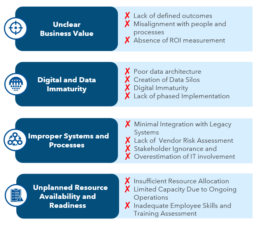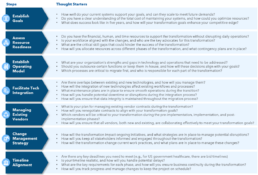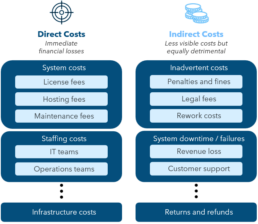Why Worry?
Over the next three years, a staggering 86% of healthcare(1) and 77% of financial institutions(2) are expected to heavily invest in technological transformation. This accelerated pace will be largely driven by AI, tech upgrades, industry consolidation, and increased outsourcing.
1. Cigna is currently transforming its healthcare services by using AI for personalized and predictive health recommendations, expanding virtual care through partnerships like MDLIVE, and enhancing customer service with AI-powered tools.
2. JPMorgan Chase is rapidly upgrading its technology infrastructure. It is integrating advanced analytics to enhance data management, improve fraud detection, and optimize customer interactions. The transformation is focused on enhancing operational efficiency, risk management, and customer experience.
3. Elevance Health, a leading health insurer, is enhancing member experience with personalized health recommendations and accelerating claims processing through AI. AI-powered bots are also improving customer service.
Despite these ambitions, 70% of all planned transformation initiatives fail(3) to deliver tangible business value. Particularly, 84% of organizations fail at tech transformations.(4)
Many technology transformation failures can be traced back to inadequate preparation. Organizations often assume that a standardized transformation strategy will meet all their needs.
A stark example is the $13 billion IT failure of the UK’s National Health Service (NHS) which aimed to create a unified electronic patient record system across all healthcare providers. However, each provider had their own existing processes, systems, and needs. The project overlooked these which led to widespread usability issues and resistance.
Similarly, UK’s TSB Bank’s IT migration underestimated the complexity of transferring 1.3 billion customer records, resulting in data discrepancies, system crashes, and widespread outages. Like them, most organizations overlook the importance of readiness in ensuring a successful transformation. This paper explores the best way to prepare for large transformations.
Common Pitfalls to Avoid
1. ASSUMING IT IS AN IT MANDATE
A common misconception is viewing transformations solely as IT tasks. Although IT is crucial for setting the technical groundwork, the true value of transformations lies in the business outcomes they enable. Without proper alignment of business requirements or an accurate assessment of the effort required, projects are prone to unrealistic expectations and inevitable setbacks.
2. INADEQUATE CHANGE STRATEGY OR DEFINED OUTCOMES
Organizations frequently embark on transformations without ensuring that their people, processes, and technology are properly aligned or without establishing a clear change management strategy. This haste often leads to missteps. A common pitfall is launching projects without clearly defined outcomes or success metrics trickled down through the organization. For example, integrating a new Customer Relationship Management (CRM) system without re-aligning the existing sales processes, org, and incentives can disrupt operations.
3. ABSENCE OF ROI
Organizations frequently overlook the importance of determining their current total cost of ownership (TCO) and relevant performance metrics. Without this, it is impossible to manage the transformation to success.
The absence of realistic scenario planning—considering potential costs, delays, and expected improvements—can result in investments that miss the mark.
Exhibit 1. Common Transformation Mistakes
4. ALL-AT-ONCE IMPLEMENTATION
By neglecting to break down the transformation into smaller, more manageable phases, companies expose themselves to operational instability and a higher likelihood of failure. When multiple business units and systems are simultaneously altered, the ability to address unforeseen issues becomes limited, leading to potential misalignment across the enterprise. This approach can overwhelm resources, disrupt daily operations, and prevent the organization from achieving a seamless unification of data and processes.
5. DIGITAL IMMATURITY
Without an in-depth evaluation of the current ecosystem, data governance, system interoperability etc., firms risk deploying newer technologies that their existing infrastructure cannot support. For example, an insurer might attempt to automate claims without realizing that its legacy systems contains inconsistent data schemas and fragmented data silos. This misalignment can lead to errors in claims validation, increased exception handling, and a surge in manual overrides, ultimately negating gains from automation.
6. POOR DATA ARCHITECTURE
Organizations often upgrade to modern systems without addressing data constraints (fragmentation and inadequate legacy systems). This oversight leads to poor data lineage and quality, traceability challenges, and inconsistent formats as ways of working still remain a legacy.
7. UNINTENDED DATA SILOS
Even when modern platforms replace legacy systems, organizations often rely on supplementary tools like data transformers and custom integrations, leading to fragmented data environments and isolated silos. This fragmentation complicates data governance, hinders data lineage tracking, and increases the risk of inconsistencies. For example, healthcare organizations are often so fragmented, it is not unusual for firms to need 300+ isolated point solutions for their day-to-day processes(5), magnifying data silos.
8. OVERLOOKING PLATFORM CAPABILITIES
Without thorough evaluation, organizations risk adopting technologies that may be incompatible, lack scalability for future growth, or fail to be backed by a reliable vendor. A solution that works well on a small scale might struggle under a full-scale deployment, especially if it cannot manage increasing data volumes or transaction complexities. This can lead to expensive overhauls or fragmented, piecemeal solutions that further complicate the IT landscape.
9. PRE-MATURE BUDGET ALLOCATION
Organizations often rush into funding new initiatives without ensuring they are prepared for the change. This can lead to neglecting crucial aspects like resource planning, negotiating with the right vendor, timeline management and more, resulting in misaligned goals, inefficient resource use, and other potential issues during implementation.
Exhibit 2. Kepler’s Readiness Assessment
Step 1: Establish Goals
DECODE CURRENT SYSTEMS AND CAPABILITIES
Start by conducting a comprehensive assessment of current systems and capabilities architecture. This involves mapping out the end-to-end process flow, identifying the teams involved, their responsibilities, and any overlaps across various teams. It is essential to consider which business units are involved and assess any limitations across the defined architecture. This assessment should include gathering requirements, not just from a technical perspective, but from all relevant areas, including business, governance, and implementation-specific needs. By identifying these baseline capabilities and requirements, organizations can create a clear foundation for the necessary changes in their transformation.
ESTIMATE TOTAL COST OF OWNERSHIP (TCO)
The current baseline extends beyond defining the architecture to mapping the entire ecosystem to it, with Total Cost of Ownership (TCO) playing a crucial role. TCO includes direct costs (systems, applications, tools) and indirect costs (employee time, downtime). Accurately assessing TCO for existing systems is vital to understanding the full financial impact. For example, a healthcare provider must consider both direct costs, like EHR licenses, and indirect costs, such as disruptions. This assessment helps compare current expenses with the benefits of new solutions, justifying investment in technological transformation.
Exhibit 3. Total Cost of Ownership (Selected) Components
HOW DO YOU COMPARE?
Once the baseline and associated costs are established, it is helpful to compare these against industry standards. This comparison is key to setting realistic and achievable future objectives. Do not limit the analysis to obvious benchmarks; instead, derive benchmarks across people, process, and technology. This approach will help uncover gaps and carry forward current successes into the transformed state.
DEFINTE FUTURE OBJECTIVES
This involves setting strategic goals such as improving operational efficiency, enhancing customer experience, or increasing market share. For example, a fintech organization might aim to streamline its customer onboarding process to improve user satisfaction and reduce processing times. Defining the future state includes specifying technological upgrades, process improvements, and performance targets. By setting these objectives, organizations can ensure that their transformation helps make measurable progress towards their strategic goals.
Step 2: Assess Resource Readiness
RESOURCE MATURITY
Auditing both labor and capital resources is essential for a successful transformation. This includes evaluating financial capacity, human resources, and time commitments to ensure that new initiatives can be implemented without disrupting ongoing operations. It also involves assessing whether internal resources are sufficient or if external support is needed, with backfilling strategies in place to prevent resource shortfalls. For example, a health plan desiring technology upgrades must assess whether it can implement a new claims processing system while maintaining current service levels or requires professional services support from external agencies.
SKILL EVALUATION & ALLOCATION
This involves developing a detailed implementation plan that outlines the specific resources required, both internally and externally, based on skill needs. The plan should map out the percentage of needs that can be met in-house versus those requiring external support, identifying the appropriate types of external partners, such as staffing agencies. Utilizing tools like skills inventories and performance reviews will help pinpoint gaps and guide targeted training programs, ensuring the workforce is adequately prepared for the transformation.
DECIPHERING ATTITUDE TOWARDS CHANGE
By conducting surveys, focus groups, interviews, and roadshows, organizations can identify common concerns and areas of resistance. This insight into the cultural landscape allows for addressing specific fears and misconceptions, creating a more supportive environment for the transformation. Successful transformation requires continuous communication, not just among decision-makers and leadership, but also with those most impacted by the change, ensuring that the process is inclusive and transparent at all levels.
RECOGNIZE CHANGE ADVOCATES
Above complemented with selecting influential employees as change champions is essential for a successful transformation. These well-respected and enthusiastic individuals can advocate for the changes and address resistance as needed.
Step 3: Establish Operating Model
Firms should proactively determine both the governance and operating model for the implementation as well as post-transformation state. This process should include defining the core functions that the operating model must support and determining the optimal allocation of resources across these functions. Organizations need to decide on the level of centralization or decentralization, ensuring that the model is designed for scalability and flexibility to adapt to future growth or changes in the market. The role of technology is also critical, requiring careful consideration of how digital tools and platforms will integrate with and enhance core operations.
Additionally, organizations must decide which processes will be standardized for consistency and which will allow for customization to meet specific needs. Effective collaboration and communication structures should be built into the model, supported by the necessary governance and oversight mechanisms to monitor performance and accountability. The integration of external partners and suppliers should be clearly defined, with roles and relationships that align with the new operating model. Finally, organizations must establish a cost structure that supports the operating model, balancing investment in transformation with the need to control ongoing operational expenses. By addressing all these factors, organizations can ensure that their operating model is well-prepared to achieve long-term success.
Step 4: Facilitate Integration
EVALUATE OVERLAPS
Understanding the overlaps between existing and new technologies is critical for ensuring seamless integration, especially when transforming legacy systems. Legacy technologies often rely on multiple wrapper systems to maintain their functionality, which can lead to redundancies during transformation. To avoid this, it’s essential to evaluate the existing ecosystem thoroughly, identifying and eliminating unnecessary overlaps. Additionally, testing the compatibility of new systems with existing ones will ensure that they complement rather than duplicate functionalities. For example, if the new system includes advanced analytics capabilities, it should enhance and integrate with current reporting tools instead of merely replicating.
PLAN DATA MIGRATION
A detailed data migration plan is essential to ensure data integrity and security throughout the transition. For example, a fintech organization might develop a plan to migrate user data from an old processing system to a new, more secure platform. This plan should include what data to migrate, how to migrate, mapping of supported data formats between existing and new systems, setting up data validation processes to check for accuracy and completeness, and conducting rigorous testing before the final migration. Ensuring that data migration is thoroughly planned and tested helps prevent data loss and minimizes disruption to business operations.
Step 5: Manage Existing Vendors
EXISTING VENDOR CONTRACTS
A comprehensive understanding of contractual terms and conditions—especially timelines, termination clauses, renewal strategies, and potential penalties—is essential during a transformation. Organizations must carefully plan integrations, determine which vendors to retain, and initiate negotiations with an emphasis on securing contractual flexibility post-implementation. Aligning contract end dates with the transformation timeline is crucial, allowing for a coordinated negotiation strategy both during and after the transition. As part of this process, there is also a need for developing strategies to mitigate risks such as service interruptions or compliance issues.
RENEGOTIATE CONTRACTS
After finalizing the ecosystem to be retained, aligning vendor contracts with the new timelines and transformation goals helps maintain smooth operations. Vendor management teams should renegotiate contract terms to reflect extended engagements, and any additional services needed. This includes aligning with new project milestones, documenting all changes, and clearly communicating these updates to relevant stakeholders. For instance, a firm might renegotiate contracts to secure additional data analytics support during the transition. Other vendors may only be required for support during parallel processing phases.
Step 6: Change Management
IMPACT ASSESSMENT
Start by assessing how the transformation will impact any ongoing initiatives. Develop strategies to manage any potential disruptions. This includes ensuring that critical projects are prioritized and protected. For example, if the introduction of a new system could interfere with an existing initiative, outline a plan to mitigate any conflicts and maintain progress on both fronts. Supplement the impact planning with comprehensive communication to keep all stakeholders informed throughout the transformation.
SOCIALIZATION & FINE-TUNING
Before finalizing any changes, large-scale socialization sessions or roadshows should be conducted to publicize the initiative and encourage early adoption. Engaging stakeholders at this stage, before the change is fully locked in, allows for valuable feedback and helps refine requirements. This proactive approach ensures that when vendors or third parties are brought in, the change is more likely to be embraced and effectively implemented.
NEW WAYS OF WORKING
Evaluate how the transformation will alter existing work practices and develop effective plans to manage these changes. Understand the impact on daily operations and prepare employees. For instance, if the transformation involves new workflows, provide clear guidelines and support to help employees adjust and integrate these changes into their routines.
Step 7: Timeline Alignment
Stress test your plans to ensure it is realistic. Break it down into specific phases, each with clear milestones and deliverables. It is important to build buffer periods to accommodate potential delays and unforeseen challenges. For instance, a fintech might use these tools to manage the rollout of a new payment gateway, allowing for real-time tracking of tasks, dependencies, and any schedule changes. This approach helps in maintaining visibility and ensuring that all team members and stakeholders are aware of the project’s status and any adjustments needed.
Begin Today
Rushing into change to keep up with trends, without adequate preparation, can lead to significant and costly consequences that span multiple time periods. When foundational elements are not properly established, organizations often find themselves needing to invest in corrective measures, such as expensive workaround solutions or “wrappers.”
Kepler Cannon has supported numerous organizations across the financial services and healthcare providers in preparing for transformation. With a well-established readiness diagnostic framework, Kepler Cannon ensures that organizations are fully equipped to tackle every aspect of readiness, enabling them to successfully navigate transformations of any scale or complexity.
The perspective in this paper provides just a glimpse into the critical dimensions that must be considered long before the actual transformation begins. By addressing these elements early on, organizations can position themselves for lasting success, avoiding the costly mistakes that come with poorly executed change efforts. The takeaway is clear: readiness is not just a step in the process; it is the foundation on which successful transformation is built.
- Flatirons
- Worldmetrics.org Report, 2024
- Harvard Business Review
- Forbes
- Software Analyst, 2023


